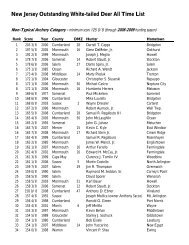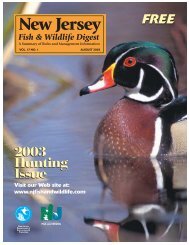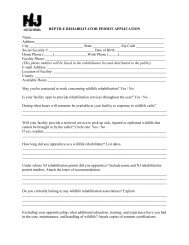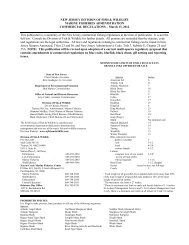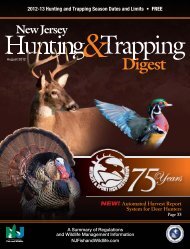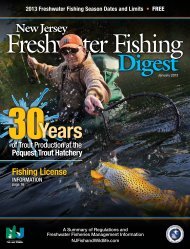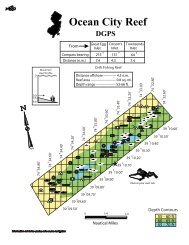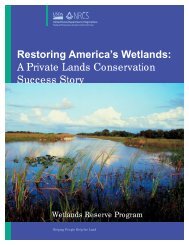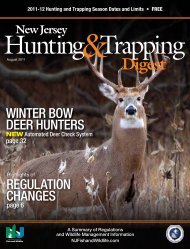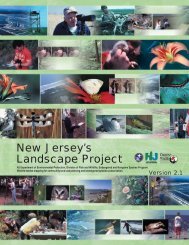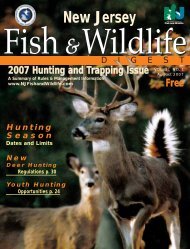Berkshire Valley Wildlife Management Area - State of New Jersey
Berkshire Valley Wildlife Management Area - State of New Jersey
Berkshire Valley Wildlife Management Area - State of New Jersey
Create successful ePaper yourself
Turn your PDF publications into a flip-book with our unique Google optimized e-Paper software.
Japanese stiltgrass can become shaded-out <strong>of</strong> the<br />
developing understory. Other invasives like garlic<br />
mustard and Japanese barberry tolerate shade well<br />
and are much more persistent. In the future, spot<br />
herbiciding prior to harvest will be done when<br />
needed to kill plants like Japanese barberry as<br />
a preventative measure. Winter or late summer<br />
harvesting and better equipment washing prior<br />
to entering the wildlife management area may<br />
reduce the occurrence <strong>of</strong> invasives.<br />
Deer Affect Forest Diversity<br />
Deer management is an important component <strong>of</strong><br />
maintaining or restoring forest health and regeneration.<br />
<strong>Berkshire</strong> <strong>Valley</strong> WMA is located within<br />
Deer <strong>Management</strong> Zone (DMZ) 6, Regulation Set 3,<br />
which allows 120 consecutive days <strong>of</strong> deer hunting<br />
<br />
varies greatly within this zone, from highly populated<br />
suburban areas along the Route 80 corridor on<br />
its southern boundary to the forested uplands along<br />
its northwestern boundary. In 2007, the estimated<br />
deer population density in the huntable portion <strong>of</strong><br />
the herd in Zone 6 was 31 deer per square mile. This<br />
is considerably lower than the estimated densities<br />
in the highly productive agricultural DMZs where<br />
40-plus deer per square mile are thought to be<br />
present. The Zone 6 density is also considerably<br />
more than the single digit density estimates for the<br />
nutrient-poor habitat <strong>of</strong> a Pinelands zone.<br />
Deer can have a huge impact on forest health and<br />
regeneration. In areas with a lot <strong>of</strong> agricultural and<br />
other vegetation able to sustain a large population<br />
<strong>of</strong> deer, high densities will not have a major impact<br />
on the surrounding forest. However, on less-productive<br />
sites, and especially when adjacent suburban<br />
development provides a refuge from hunters, deer<br />
can have a significant impact on forest vegetation.<br />
In 2010, two <strong>of</strong> the harvest blocks at <strong>Berkshire</strong><br />
<br />
<br />
areas to regenerate without influence from deer.<br />
Plant diversity, along with the calculated total<br />
height <strong>of</strong> tree species within and outside <strong>of</strong> the deer<br />
<br />
and used to gauge the long-term impacts from deer.<br />
Regardless <strong>of</strong> the estimated density, the ultimate<br />
test <strong>of</strong> deer density-habitat compatibility in any one<br />
location is the amount <strong>of</strong> plant regeneration present.<br />
At <strong>Berkshire</strong> <strong>Valley</strong>, evidence such as the amount<br />
<strong>of</strong> understory browse observed and the vegetation<br />
<br />
some plant species are preferred by deer (e.g. maple<br />
<br />
density and that hunting pressure is adequate.<br />
Plant Diversity Supports Forest Birds<br />
A breeding bird survey was conducted during June<br />
<strong>of</strong> 2008 and found species including those that prefer<br />
Two deer exclosures were installed to look at deer impacts on regenerating stands.<br />
Regrowth in areas cut in 2008 has resulted in a<br />
dense, diverse assemblage <strong>of</strong> plants.<br />
“interior forest” for nesting (like wood thrush and<br />
scarlet tanager), as well as those that require scrub/<br />
shrub (prairie warbler) and species who need a<br />
well developed understory (worm eating warbler,<br />
black-billed cuckoo). Though many birds that nest<br />
in “interior forest” will not nest in the regenerating<br />
cuts, this habitat is important to them for foraging<br />
after the young fledge and also during migration.<br />
The great abundance <strong>of</strong> berries and insects on the<br />
plants in the cuts makes them a desirable habitat type.<br />
Focus on Grouse<br />
Since one <strong>of</strong> the main goals <strong>of</strong> the forest management<br />
work at <strong>Berkshire</strong> <strong>Valley</strong> was to create grouse<br />
habitat, it is important to monitor the effects on this<br />
species. At one time grouse were fairly common on<br />
<strong>Berkshire</strong>. Grouse surveys conducted during April<br />
and May <strong>of</strong> the last two years have not been fruitful.<br />
It is possible that sufficient source populations do<br />
<br />
<br />
the regenerating habitat. Perhaps there is not yet<br />
enough early successional vegetation in this area.<br />
The home range for a pair <strong>of</strong> grouse is from<br />
50-100 acres, providing there is suitable habitat.<br />
The farther a grouse must travel to meet its living<br />
and breeding requirements, the more likely it is<br />
Opening the canopy to sunlight stimulates the<br />
growth <strong>of</strong> seedlings present before the harvest<br />
(like oak and beech) and releases shade-intolerant<br />
species like birch and ash.<br />
subject to predation. Localized predation from<br />
raptors, cats, raccoons and other predators may be<br />
having an impact on these birds. Disturbance from<br />
illegal ATV and dirt bike activity could also thwart<br />
nesting. It is probably a combination <strong>of</strong> factors.<br />
Successional Success<br />
Activities at <strong>Berkshire</strong> <strong>Valley</strong> <strong>Wildlife</strong> <strong>Management</strong><br />
<br />
management is used successfully as a tool to create<br />
wildlife habitat. Two more rounds <strong>of</strong> timber harvests<br />
are planned under the current management<br />
plan. These cuts are scheduled to take place in 2013<br />
and 2018. By choosing a “no-action” alternative<br />
(no management activity) it will not change the<br />
fact that invasives are likely to be present in the<br />
future stand. The result <strong>of</strong> no action will be little<br />
regeneration <strong>of</strong> trees like oak that need an open<br />
canopy and sunlight reaching the forest floor in<br />
order to thrive. No action will also be detrimental<br />
to a suite <strong>of</strong> species that need the structure and<br />
food supply <strong>of</strong> an early successional forest. Without<br />
oaks in future stands the outlook for wildlife that<br />
depends on oak is bleak. Tolerating some invasives<br />
may be necessary in order to achieve a diversity <strong>of</strong><br />
forest successional stages that is so crucial to forest<br />
health and wildlife diversity.<br />
August 2011 For more information contact <strong>New</strong> <strong>Jersey</strong> <strong>New</strong> <strong>Jersey</strong> Fish & <strong>Wildlife</strong> Digest | 81<br />
Division <strong>of</strong> Fish and <strong>Wildlife</strong> at (609)292-2965<br />
2011 Hunting and Trapping Issue





